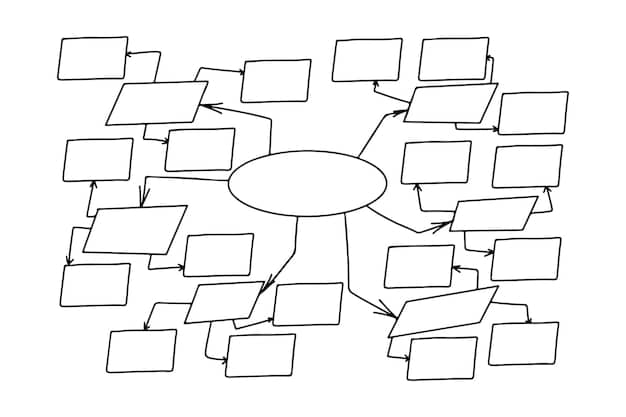Plain Language Power: Improve Communication by 20% in 3 Months

Achieving a 20% improvement in communication clarity within three months is attainable by implementing strategic plain language principles, which streamline messages, enhance comprehension for diverse audiences, and foster more effective interactions across various settings.
Have you ever felt lost in a sea of jargon or confused by overly complex instructions? You’re not alone. The ability to communicate clearly and effectively is a cornerstone of success in virtually every field, and mastering The Power of Plain Language: Improving Communication Clarity by 20% in 3 Months can be a game-changer.
understanding the essence of plain language
Plain language isn’t about dumbing down content; it’s about making complex information accessible to everyone. It involves using clear, concise, and straightforward words and sentence structures, ensuring that your audience can easily understand what you’re trying to convey without ambiguity or unnecessary effort. This approach is rooted in the principle that effective communication is a two-way street: the message must be sent clearly and received with full comprehension.
The goal is to eliminate barriers that often arise from technical jargon, overly formal phrasing, or convoluted sentences. When information is presented plainly, it reduces cognitive load, allowing readers to grasp the core message quickly and accurately. This not only saves time for both the writer and the reader but also minimizes misinterpretations and errors often stemming from poor communication.
defining plain language principles
Several core principles underpin effective plain language. Adhering to these guidelines helps ensure your message is clear, direct, and actionable.
- Know your audience: Tailor your language to their knowledge level and needs.
- Use common words: Opt for simpler words over complex synonyms.
- Short sentences: Break down long sentences into shorter, more manageable ones.
- Active voice: Prefer active voice to make sentences clearer and more direct.
These principles aren’t just stylistic choices; they are fundamental to creating content that truly communicates. For instance, using active voice makes it clear who is doing what, reducing ambiguity. Similarly, breaking down long sentences prevents readers from getting lost in complex grammatical structures.
the global impact of clear communication
In a world increasingly connected, the need for clear communication transcends national borders and cultural differences. Organizations like the Plain Language Association International (PLAIN) advocate for clear communication across governments, businesses, and non-profits worldwide. Their work highlights that plain language is not a niche skill but a universal necessity for improved understanding and reduced friction.
In the United States, the Plain Writing Act of 2010 mandates that federal agencies use clear government communication that the public can understand and use. This legislation underscores the importance of plain language in ensuring transparency and accessibility for citizens. Similar initiatives are gaining traction globally, reinforcing the idea that clear language is a civil right.
Beyond compliance, businesses are recognizing that plain language boosts customer satisfaction, reduces support calls, and improves internal efficiency. When employees understand internal communications, productivity rises, and errors decrease. For customers, clear instructions lead to better product usage and fewer complaints.
identifying current communication challenges
Before any improvement can occur, it’s crucial to acknowledge where current communication strategies fall short. Many organizations and individuals struggle with communication, often unaware of the underlying issues that impede clarity and understanding. Recognizing these challenges is the first step toward implementing effective plain language solutions.
A common pitfall is the overuse of jargon and technical terms, particularly within specialized fields. While industry-specific language can be efficient for internal communication among experts, it quickly becomes an impenetrable barrier when communicating with external audiences or those unfamiliar with the terminology. This often alienates readers and can lead to frustration and disengagement.
Another prevalent issue is the tendency towards lengthy and convoluted sentences. Writers sometimes believe that complex sentence structures convey intelligence or authority, but they often do the opposite. Long sentences, filled with multiple clauses and abstract concepts, force readers to expend significant cognitive effort to decipher the message, leading to fatigue and diminished comprehension.
common pitfalls in communication
Understanding these pitfalls helps in avoiding them and building a stronger foundation for clear communication.
- Jargon overload: Using technical terms without explanation.
- Passive voice: Creating vague sentences and obscuring responsibility.
- information dumping: Presenting too much information at once.
- Lack of audience focus: Failing to tailor messages to the recipient’s needs.
These issues often compound each other, creating a cumulative effect of confusion. For example, a document filled with jargon and written in the passive voice can become virtually unintelligible, even if the underlying content is vital.

the cost of unclear messages
The consequences of poor communication are far-reaching and costly. In business, it can lead to misdirected projects, wasted resources, and lost revenue. Customer service centers are often inundated with queries that could have been avoided if initial instructions or product descriptions were clearer. Internally, unclear communication can foster a culture of misunderstanding, reduce morale, and hinder decision-making processes.
Consider the legal implications: contracts and agreements rife with ambiguous language can lead to costly disputes and litigation. In healthcare, patient instructions that are not plainly understood can result in incorrect medication dosages or improper adherence to treatment plans, posing serious health risks. These examples highlight that clear communication isn’t just about politeness; it’s about tangible outcomes affecting lives and livelihoods.
Moreover, unclear communication erodes trust. When an audience consistently struggles to understand a message, they may begin to doubt the sender’s competence or sincerity. This trust deficit can be particularly damaging for public institutions, where transparency and reliability are paramount.
strategic implementation of plain language
Implementing plain language isn’t a one-time fix; it requires a strategic, systematic approach. It involves more than just simplifying words; it’s about reshaping how information is conceived, created, and delivered across an organization. This multi-faceted strategy focuses on training, establishing clear guidelines, and integrating plain language into every communication touchpoint.
The initial phase often involves raising awareness about the benefits of plain language and conducting an audit of existing communications. This assessment helps identify areas most in need of improvement and provides a baseline against which future progress can be measured. It’s essential to involve key stakeholders from various departments to ensure buy-in and a holistic approach.
Once the audit is complete, developing a clear set of plain language guidelines tailored to the organization’s specific needs and audience is crucial. These guidelines should be practical, easy to follow, and supported by concrete examples. They should cover aspects like vocabulary choice, sentence structure, the use of headings and bullet points, and even considerations for visual communication.
training and education modules
Effective implementation hinges on comprehensive training programs. These shouldn’t be limited to professional writers but extended to anyone involved in creating public-facing or critical internal communications.
- Workshops: Interactive sessions focusing on plain language principles.
- Online courses: Self-paced modules for flexible learning.
- Style guides: Providing readily accessible plain language rules and examples.
- Peermore reviews: Encouraging colleagues to review content for clarity.
Training should include practical exercises, such as rewriting complex documents into plain language versions. This hands-on experience helps participants internalize the principles and apply them effectively in their daily work. Regularly reinforcing these concepts through follow-up sessions and resource sharing is also vital.
integrating into content workflows
Plain language shouldn’t be an afterthought; it should be woven into the fabric of content creation. This means incorporating plain language reviews at various stages of the content workflow, from initial drafting to final editing.
Tools and templates can also facilitate this integration. For example, using templates with built-in plain language prompts or checklists can guide writers toward clearer communication. Moreover, investing in plain language software or plugins for content management systems can offer real-time feedback and suggestions, helping writers adhere to guidelines as they compose.
Another powerful strategy is to establish a designated plain language champion or team within the organization. This individual or group can provide ongoing support, conduct quality checks, and serve as a resource for colleagues seeking guidance on clear communication. Regular feedback loops, where communication effectiveness is measured and discussed, are also crucial for continuous improvement.
measuring success: a 20% clarity improvement
Achieving a 20% improvement in communication clarity within three months might seem ambitious, but it is entirely attainable with a focused and systematic approach. The key lies in setting measurable goals, employing specific plain language metrics, and consistently gathering feedback. This section outlines how to define and track this improvement, ensuring that efforts translate into tangible results.
The first step is to establish a baseline. Before implementing any changes, assess the current clarity level of your communications. This can be done through various methods, such as readability scores (e.g., Flesch-Kincaid), user surveys, or expert reviews. A quantitative baseline provides a starting point against which progress can be objectively measured. Without it, knowing if your efforts are yielding results is challenging.
Once the baseline is established, specific plain language goals should be set. For example, a goal might be to reduce the average sentence length by 15%, increase the use of active voice by 20%, or improve readability scores by a certain percentage. These quantifiable targets make it easier to track progress and identify areas that require further attention.
key metrics for measurement
Measuring communication clarity involves a combination of quantitative and qualitative metrics. Each provides a different perspective on how well your message is being received.
- Readability scores: Tools like Flesch-Kincaid Readability Test assess text difficulty.
- Task completion rates: Measuring how many users successfully complete tasks based on instructions.
- User satisfaction surveys: Gathering feedback on perceived clarity and ease of understanding.
- Reduction in support inquiries: Fewer questions indicate better understood information.
These metrics should be tracked consistently throughout the three-month period. Regular monitoring allows for mid-course corrections and ensures that the plain language initiatives remain on track. For instance, if readability scores aren’t improving as expected, it might indicate a need for more intensive training or a revision of the plain language guidelines.
collecting and analyzing feedback
Feedback is invaluable for understanding the real impact of your plain language efforts. It provides insights that quantitative metrics might miss, revealing nuances in user comprehension and experience.
Surveys can be deployed to gauge user understanding and satisfaction with revised communications. Asking specific questions, such as “Was this information easy to understand?” or “Did you find what you were looking for quickly?”, can provide direct insights. Focus groups and user testing sessions offer more in-depth qualitative data, allowing you to observe how users interact with your content and where they encounter difficulties.
Analyzing feedback goes beyond simply aggregating responses. It involves identifying patterns, uncovering root causes of confusion, and using these insights to refine your plain language strategy. For example, if multiple users highlight the same point of confusion, it signals an area needing immediate attention and revision.
Furthermore, A/B testing different versions of communications can provide empirical evidence of which plain language approaches are most effective. By comparing key metrics (e.g., click-through rates, task completion) between a control version and a plain language version, you can concretely demonstrate the benefits of improved clarity.
practical strategies for rapid improvement
To achieve a 20% improvement in communication clarity within a tight three-month timeframe, a strategic combination of practical, actionable strategies is essential. This requires not just theoretical understanding but hands-on application and a commitment to continuous refinement. The focus should be on immediate impact techniques that can be quickly integrated into daily communication practices.
One of the most effective strategies is to adopt a “write-first, simplify-later” approach. This means getting your ideas down initially without overthinking perfect phrasing, then dedicating a specific phase to reviewing and simplifying. During the simplification phase, actively look for opportunities to replace jargon with common terms, break long sentences, and rephrase passive voice constructions into active ones. This two-step process helps maintain the flow of ideas while ensuring clarity post-production.
Another powerful tactic is to practice empathy writing. Before composing any message, take a moment to consider your audience’s perspective. What do they already know? What do they need to know? What questions might they have? Anticipating these points allows you to tailor your message so it directly addresses their needs and concerns, making it inherently clearer and more relevant.
actionable tips for quick wins
These tips are designed to provide immediate improvements in clarity, serving as building blocks for more significant changes.
- Replace jargon: Swap complex or technical terms with simpler, everyday words.
- Shorten sentences: Aim for sentences averaging 15-20 words.
- Use active voice: Identify the subject and verb to make sentences direct.
- Bullet points & lists: Break down dense paragraphs into digestible lists.
These techniques are highly effective because they directly address common causes of confusion. For instance, replacing jargon immediately opens up your message to a wider audience, while using bullet points makes complex information easier to scan and comprehend at a glance.

leveraging digital tools for clarity
In the digital age, numerous tools can assist in enhancing communication clarity. Readability checkers, often integrated into word processors or available as standalone applications, can provide instant feedback on text complexity. These tools highlight long sentences, passive voice, and difficult words, guiding you towards simpler language.
Grammar and style checkers, like Grammarly or Hemingway Editor, go beyond basic spell-checking to offer suggestions for improving conciseness, clarity, and overall readability. While not a substitute for human judgment, they can be valuable assistants, especially for quick edits and self-correction.
Furthermore, collaborative writing platforms (e.g., Google Docs, Microsoft 365) enable real-time feedback from peers. Encouraging colleagues to review drafts specifically for plain language principles can catch ambiguities or complexities that the original author might overlook. A fresh pair of eyes, especially from someone representing the target audience, can provide invaluable insights.
Finally, utilize visual communication elements strategically. Infographics, flowcharts, and well-chosen images can often convey complex information more effectively than words alone. Integrating these visuals should be part of the plain language strategy, ensuring they are themselves clear, concise, and complementary to the text.
sustaining clarity: long-term plain language habits
Achieving a 20% improvement in communication clarity within three months is a significant accomplishment, but the true challenge lies in sustaining that improvement over the long term. Plain language isn’t a project with an endpoint; it’s an ongoing commitment that requires developing consistent habits and integrating the principles into the organizational culture. This final phase focuses on embedding plain language as a core value and continuous practice.
One of the most critical long-term strategies is to establish a culture where plain language is not just encouraged but expected. This means leadership championing the cause, providing ongoing resources, and recognizing efforts to improve clarity. When clear communication is visibly valued by management, it sends a powerful message throughout the organization, motivating employees to adopt and maintain these practices.
Regular reviews and updates of plain language guidelines are also essential. As language evolves, new terms emerge, and audiences change, the guidelines should be dynamic and adaptable. Periodically assessing the effectiveness of current guidelines and making necessary revisions ensures they remain relevant and useful.
embedding plain language in culture
To make plain language a natural part of daily operations, it needs to be integrated into various aspects of organizational life.
- Ongoing training: Regular refreshers and advanced workshops.
- Feedback loops: Continuous mechanisms for assessing and improving clarity.
- Style guides: Regularly updated resources with examples and best practices.
- Leadership buy-in: Management actively promoting and demonstrating clear communication.
Creating opportunities for cross-departmental collaboration on communication projects can also foster a shared understanding of plain language principles. When different teams work together, they can learn from each other’s approaches and collectively reinforce best practices.
the virtuous cycle of clear communication
Sustaining plain language creates a virtuous cycle. As communication becomes clearer, understanding improves, leading to better decision-making, increased efficiency, and enhanced trust. These positive outcomes, in turn, reinforce the value of plain language, motivating continued adherence to its principles.
For individuals, cultivating the habit of reviewing their own writing for clarity before sending it out is crucial. This self-editing practice, aided by the tools and guidelines mentioned earlier, can significantly reduce the need for revisions later. It also builds a stronger individual capacity for effective communication.
Finally, celebrate successes. When an initiative or project benefits significantly from plain language, highlight it. Sharing positive outcomes, whether it’s a reduction in customer support calls or a smoother internal process due to clearer documentation, reinforces the tangible benefits and maintains momentum for future efforts.
By making plain language an ingrained part of how an organization operates, it transcends being a temporary project to become a fundamental pillar of its success. The initial 20% improvement becomes just the beginning of a journey towards consistently exceptional and understandable communication.
| Key Point | Brief Description |
|---|---|
| 📝 Define Plain Language | It’s about clear, concise, and understandable communication, not simplification. |
| 🔎 Identify Challenges | Recognize jargon overuse, complex sentences, and audience mismatch. |
| 📈 Measure Improvement | Use readability scores, user feedback, and task completion rates to track progress. |
| 🚀 Sustain Habits | Integrate plain language into culture with ongoing training and review. |
frequently asked questions
▼
Plain language focuses on clear, concise, and accessible communication, avoiding jargon and complex structures. It’s crucial for achieving a 20% clarity improvement because it directly addresses comprehension barriers, leading to faster understanding, fewer errors, and enhanced engagement across diverse audiences. This efficiency translates into tangible benefits.
▼
Measuring a 20% improvement involves a baseline assessment using readability scores (e.g., Flesch-Kincaid). Track improvements in these scores, coupled with qualitative data like user satisfaction surveys, reduced support inquiries, and higher task completion rates. Combining quantitative and qualitative metrics provides a comprehensive view of clarity enhancement.
▼
To achieve rapid improvement, start by training key communicators, replacing jargon with common words, shortening sentences, and using active voice. Break down dense text with bullet points and clear headings. Leveraging digital tools like readability checkers can provide instant feedback and accelerate the learning process for all team members.
▼
Absolutely. Plain language is not about oversimplification but about making complex information understandable without losing accuracy. For technical documents, this means explaining specialized terms, using clear visuals, structuring content logically, and employing consistent terminology. The goal is to ensure the intended audience grasps core concepts efficiently, regardless of complexity.
▼
Sustaining plain language requires embedding it into the organizational culture. This involves ongoing training, establishing clear style guides, conducting regular communication audits, and seeking continuous feedback. Leadership must champion plain language, recognizing its value in everyday operations. Consistent reinforcement ensures these practices become second nature.
conclusion
Improving communication clarity by 20% in just three months is an ambitious yet entirely achievable goal through the disciplined application of plain language principles. From understanding its core tenets to strategically implementing practical changes and diligently measuring progress, the journey towards enhanced clarity is transformative. Beyond mere words, it fosters greater understanding, mitigates costly errors, and builds stronger, more trusting relationships with every message conveyed. By embedding plain language as an ongoing commitment, organizations and individuals alike can unlock a virtuous cycle of effective communication, driving sustained success and impactful engagement.





